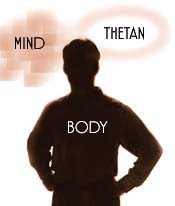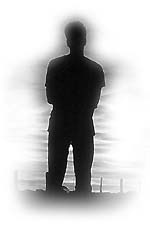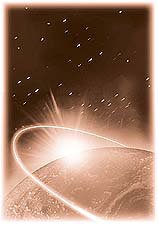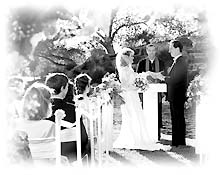A Description of Scientology
February 2010
by the Church of Scientology Australia
DESCRIPTION OF THE SCIENTOLOGY RELIGION
The Creed of the Church of Scientology was written by L. Ron Hubbard shortly after the Church was formed in Los Angeles on February 18, 1954 .
After he issued this creed from his office in Phoenix, Arizona, the Church of Scientology adopted it as official because it succinctly states what Scientologists believe.
We of the Church believe:
That all men of whatever race, colour or creed were created with equal rights;
That all men have inalienable rights to their own religious practices and their performance;
That all men have inalienable rights to their own lives;
That all men have inalienable rights to their sanity;
That all men have inalienable rights to their own defense;
That all men have inalienable rights to conceive, choose, assist or support their own organizations, churches and governments;
That all men have inalienable rights to think freely, to talk freely, to write freely their own opinions and to counter or utter or write upon the opinions of others;
That all men have inalienable rights to the creation of their own kind;
That the souls of men have the rights of men;
That the study of the mind and the healing of mentally caused ills should not be alienated from religion or condoned in nonreligious fields;
And that no agency less than God has the power to suspend or set aside these rights, overtly or covertly.
And we of the Church believe:
That man is basically good;
That he is seeking to survive;
That his survival depends upon himself and upon his fellows and his attainment of brotherhood with the universe.
And we of the Church believe that the laws of God forbid man:
To destroy his own kind;
To destroy the sanity of another;
To destroy or enslave another’s soul;
To destroy or reduce the survival of one’s companions or one’s group.
And we of the Church believe that the spirit can be saved and that the spirit alone may save or heal the body.
DOCTRINE OF THE SCIENTOLOGY RELIGION
While Scientology owes a spiritual debt to the Eastern faiths, it was born in the West and its beliefs are expressed in the technical language of the mid-Twentieth Century. Scientology adds to these spiritual concepts, a precise and workable technology for applying those concepts to life.

Scientology religious doctrine includes certain fundamental truths. Prime among them are that man is a spiritual being whose existence spans more than one life and who is endowed with abilities well beyond those which he normally considers he possesses. He is not only able to solve his own problems, accomplish his goals and gain lasting happiness, but also to achieve new states of spiritual awareness he may never have dreamed possible.
Scientology holds that man is basically good, and that his spiritual salvation depends upon himself, his relationships with his fellows and his attainment of brotherhood with the universe. In that regard, Scientology is a religious philosophy in the most profound sense of the word, for it is concerned with no less than the full rehabilitation of man’s innate spiritual self—his capabilities, his awareness, and his certainty of his own immortality.
And, in the wider arena, through the spiritual salvation of the individual, Scientology seeks the ultimate transformation—”a civilization without insanity, without criminals and without war, where the able can prosper and honest beings can have rights, and where man is free to rise to greater heights.”
In one form or another, all great religions have held the hope of spiritual freedom—a condition free of material limitations and suffering. Scientology offers a very practical approach to attaining this spiritual aim. Of this, L. Ron Hubbard wrote: “For countless ages a goal of religion has been the salvage of the human spirit. Man has tried by many practices to find the pathway to salvation. He has held the imperishable hope that someday in some way he would be free.” Mr. Hubbard continued, “And here, after these ages of grief and suffering, through terrible wars and catastrophe, the hope still lives—and with that hope, accomplishment.”
Thus, while the hope for such freedom is ancient, what Scientology is doing to bring about that freedom is new. And the technologies with which it can bring about a new state of being in man are likewise new. An understanding of these beliefs will illustrate how Scientology fits within the religious and spiritual traditions of the world.
DIANETICS
L. Ron Hubbard’s path to the founding of the Scientology religion began with certain discoveries he made in his research into the nature of man. He announced his findings in 1948 as “Dianetics,” a word which means “through the soul” or what the spirit is doing to the body. With Dianetics, Mr. Hubbard discovered a previously unknown and harmful part of the mind which contains recordings of past experiences of loss, pain and unconsciousness in the form of mental image pictures. These incidents of spiritual trauma are recorded along with all other experiences of one’s life in sequential order on what Scientologists call the time track.
The painful incidents recorded on this time track exist below a person’s level of awareness and collectively accumulate to make up what is called the reactive mind, the source of all travail, unwanted fears, emotions, pains, and psychosomatic illnesses—as distinct from the analytical mind, that portion of the mind which thinks, observes data, remembers it and resolves problems.
Dianetics provided a method to address the reactive mind by uncovering this previously unknown spiritual trauma and erasing its harmful effects on an individual.
When this occurs, one has achieved a new state of spiritual awareness called Clear.
One’s basic and fundamental spirituality, personality, his artistry, personal force and individual character, his inherent goodness and decency, are all restored.
While the Clear is analogous to the state of awareness in Buddhism call the Bodhi, or enlightened one, the Clear is a permanent level of spiritual awareness never attainable prior to Dianetics and Scientology.
THE THETAN
For all that Dianetics resolved, the actual nature of the spiritual being was still unknown, even though it was apparent from the beginning that this was a question which would one day need resolution.

The breakthrough from Dianetics to Scientology came in the autumn of 1951, after Mr. Hubbard observed many people practicing Dianetics and found a commonality of experience and phenomena which were of a profoundly spiritual nature—contact with past-life experiences.
After carefully reviewing all relevant research data, Mr. Hubbard isolated the answer: Man had been misled by the idea that he had a soul. In fact, man is a spiritual being, who has a mind and a body. The spirit is the source of all that is good, decent and creative in the world: it is the individual being himself. With this discovery, Mr. Hubbard founded the religion of Scientology, for he had moved firmly into the field traditionally belonging to religion—the realm of the human spirit.
Awareness of the human spirit has existed as a universal ingredient of almost every religion in every culture. However, each defined the spiritual essence of man differently. Terms such as “spirit” and “soul” were encumbered by centuries of various meanings. A new word was needed. Mr. Hubbard adopted the Greek letter theta (θ), which he had assigned in 1950 to represent the transcendent “life force.” By adding an “n,” the word “thetan” thus described the individual unit of “life force”— the spiritual being—which is the person.
THETA AND MEST

mindlessly contributing some “lucky” voltage, but the volitional, spiritual element of theta taking an elemental step in the creation and conquest of mest.
In more general terms, the term theta describes the life force which animates all living things. This life force is separate from, but acts upon, the physical universe, which consists of matter, energy, space and time (called “MEST” in Scientology).
Scientology is built on a series of fundamental truths called the Axioms, which define theta and MEST and describe how the two interrelate to form life as we know it. The Axioms comprise the fundamental elements of the beliefs of the Scientology religion.
First published in 1954, the Axioms of Scientology present this doctrinal foundation with a definition of theta as a “life static” which has no mass, no wavelength, no location in space or in time. It has the ability to influence and change its environment and achieve total knowingness.
CREATION
Scientology holds that it is the action of this non-material life static, playing upon the kinetic of the physical universe, which results in the manifestation of life. All living organisms are composed of matter and energy existing in space and time, animated by theta.
To a Scientologist, life is thus neither accidental nor purposeless, and the answers to questions of creation and evolution are found in Scientology. Materialists have sought to explain life as a spontaneous accident and evolution as a haphazard process of “natural selection.” But these theories never ruled out that additional factors may be merely using such processes as evolution. Most of the world’s religions express some view of the creation of the world.
Some religious traditions, such as Hindu and Buddhist, see the universe as essentially eternal, without beginning or end in the stream of time as we perceive it. The first books of the Bible contain an account of the creation of the universe which some Christian faiths hold to be allegorical and some hold to be an expression of literal fact.

mindlessly contributing some “lucky” voltage, but the volitional, spiritual element of theta taking an elemental step in the creation and
conquest of mest.
Other religious traditions have other views, but each attempts to explain this ultimate question of where we came from and how it occurred. In Scientology, this view flows from the theory of theta creating MEST; in fact, it could be said that the creation of the universe is an inseparable part of that theory. The origins of theta and the creation of the physical universe set forth in Scientology are described in The Factors, written by Mr. Hubbard in 1954 (visit www.bonafidescientology.org and search for “The Factors”)
Just as the combination of theta and MEST produces life, their separation is
synonymous with death of the organism. The human body, like all life forms, follows a cycle of birth, growth and survival, and ultimately death. The thetan, however—the individualized “unit” of life energy which is the person—is not of the universe of matter, energy, space and time and thus does not cease to exist when the body dies. It is immortal.
As Mr. Hubbard observed, “A Scientologist, before he has gone very far, begins to realize the nature of the universe. He realizes this didn’t all just occur spontaneously one fine day out of some scientific formula, and he realizes there must have been an Author to all of these things. And he also realizes, oddly enough, in his own participation.”
SPIRITUAL ENTRAPMENT BY MEST
The creation and animation of life forms is part of the process by which theta accomplishes its goal in the physical universe, which is the conquest of MEST— expressed in some religions as a conflict between order and chaos. This goal is made necessary by the fact that the physical universe—MEST—tends to encumber the thetan and cause it to act contrary to its true spiritual nature.
Although Scientologists hold that the immortal thetan is intrinsically good,
Scientology posits that he has lost his spiritual identity and operates at a small fraction of his natural ability. It is this loss of spiritual identity that causes man to be unhappy or to act irrationally and with evil intent, even though he is inherently good and highly ethical.
This “fall from perfection” is not due to Satan’s intervention or man’s natural evil impulses, as Judeo-Christian-Muslim religious theology maintains. Rather, Scientology postulates that it is caused by the thetan’s own experiences, whether in current or prior lives. As these experiences accumulate over time, they cause the thetan to become enmeshed with the material universe.
It is through Scientology’s central religious practices, as described in Chapter III, that the thetan is able to extricate himself from this entrapment. This is analogous to the concept of salvation found in other religions.
SALVATION
Scientology’s path to spiritual salvation differs from that taken by religions of the Judeo-Christian tradition. In part, this is due to Mr. Hubbard’s discovery of the thetan’s immortality and its separateness from the mind and the body. This fact aligns Scientology much more to Eastern traditions of religious thought in many ways, including their concepts of salvation.

Jews and Christians believe the soul lives only once, and Christians believe that upon death the soul is resurrected as a spiritual body in heaven or hell. Like the Buddhist, the Hindu, and even some early Christians, Scientologists believe that the thetan assumes many bodies through its repeated contacts with the physical universe.
Scientologists also believe that the thetan, and therefore man, is basically good. In contrast, Jews and Christians follow the Old Testament teaching that man has two intrinsic impulses—one good and the other evil—that are constantly competing, just as the perceived cosmic struggle between God and Satan.
According to this Judeo-Christian framework, man’s plight is to overcome his evil side. Jewish theology states he can do this by observing the finely crafted rules of the Torah. Christian theology teaches he must, at minimum, accept Christ’s resurrection as a matter of faith. In either case, the promise of salvation is not realized until death.
Salvation in the Scientology religion is much different and much more immediate.
In the tradition of certain Eastern religions, Scientology teaches that salvation is attained through increasing one’s spiritual awareness. The complete salvation of the thetan, called “Total Freedom” in Scientology, is attainable through the practice of Scientology religious services.
As one’s spiritual awareness grows through practicing Scientology, so does his ability to determine his own answers and solutions about life, the spirit and eternity, and to know them with absolute certainty. Ultimately, the individual is aware of himself as a spirit, independent of the flesh, and that he will survive with memory and identity intact.
THE EIGHT DYNAMICS
One fundamental and unifying factor that runs throughout Scientology’s view of the universe is that the primary goal of all life forms – including the thetan—is towards infinite survival. The urge is so powerful and so universal that it is known as the “dynamic principle of existence.” This dynamic principle of existence is itself divided into eight distinct parts, called the “eight dynamics,” each representing one aspect of the survival dynamic. Viewed as concentric circles expanding outward from a common centre, the eight dynamics represent an increasing awareness of and participation in all of life’s elements. These dynamics represent Scientology’s view of the cosmos.

The first dynamic is SELF. This is the urge toward existence and survival as an individual, to be an individual, and to attain the highest level of survival for the longest possible time for self. Here we have individuality expressed fully.
The second dynamic is FAMILY. This is the urge toward existence and survival through sex and the rearing of children. It stands for creativity, for making things for the future, and it includes the family unit.
The third dynamic is GROUPS. This is the urge toward existence and survival through a group of individuals, with the group tending to take on a life and existence of its own. A group can be a club, friends, a community, a company, a social lodge, a state, a nation, or even a race.
The fourth dynamic is SPECIES. This is the urge toward existence and survival through all mankind and as all mankind.
The fifth dynamic is LIFE FORMS. This is the urge toward existence and survival as life forms and with the help of life forms such as all animals, birds, insects, fish and vegetation, or anything motivated by life. It is, in short, the effort to survive for any and every form of life. It is the interest in life as such.
The sixth dynamic is PHYSICAL UNIVERSE. This is the urge toward existence and survival of the physical universe, by the physical universe itself and with the help of the physical universe and each one of its component parts—matter, energy, space and time.

The seventh dynamic is SPIRITS. This is the urge toward existence and survival as spiritual beings or the urge for life itself to survive. Anything spiritual, with or without identity, would come under the heading of the seventh dynamic. The seventh dynamic is the life source, or theta. This is separate from the physical universe and is the source of life itself. Thus, there is an effort for the survival of theta as theta.
The eighth dynamic is the urge toward existence and survival as INFINITY. The eighth dynamic also is commonly called God, the Supreme Being or Creator, but it is correctly defined as infinity. It actually embraces the “All-ness” of All.
Mr. Hubbard wrote about the interrelationship of the sixth, seventh and eighth dynamics:
“The theta universe is a postulated reality for which there exists much evidence. If one were going to draw a diagram of this, it would be a triangle with the Supreme Being at one corner, the MEST universe at another and the theta universe at the third.
Too much evidence is forthcoming in research to permit us to overlook this reality. Indeed, the assumption of this reality is solving some of the major problems of the humanities….”
Because the fundamentals upon which Scientology rests embrace all aspects of life, certain key principles which permeate the religion can also be broadly employed to better any aspect of life. Moreover, the principles greatly clarify what is so often confusing and bewildering. And, through Scientology, a person realizes that his life and influence extend far beyond himself. He becomes aware also of the necessity to participate in a much broader spectrum.
By understanding each of these dynamics and their relationship, one to the other, he is able to do so, and thus increase survival on and participation in all these dynamics.
Thus, as a Scientologist expands his awareness, participation and responsibility outward along the dynamics, he will ultimately arrive at the eighth dynamic, survival through Infinity, or the Supreme Being. That is why, according to Mr. Hubbard, “When the seventh dynamic is reached in its entirety, one will only then discover the true eighth dynamic.”
SUPREME BEING
There are probably at least as many concepts of the Supreme Being or ultimate reality as there are religions. Christianity is monotheistic. Hinduism is a polytheistic faith. Branches of Buddhism do not believe in a Supreme Being in any form whatsoever. As many religious scholars note, Scientology in this respect is more like Western religions and shares their view that places the Supreme Being at the pinnacle of the cosmos.
According to Mr. Hubbard, a man who does not share a belief in a Supreme Being is not really a man. Mr. Hubbard wrote:
“No culture in the history of the world, save the thoroughly depraved and expiring ones, has failed to affirm the existence of a Supreme Being. It is an empirical observation that men without a strong and lasting faith in a Supreme Being are less capable, less ethical and less valuable to themselves and society. … A man without an abiding faith is, by observation alone, more a thing than a man.”
Many religions characterize the Supreme Being (whether called Yahweh, God, Allah, or something else) in such terms as omnipotent, omniscient, beneficent, judgmental, demanding, or attribute to the Supreme Being other generally anthropomorphic qualities.
Scientology differs from these other religions in that it makes no effort to describe the exact nature or character of God. In Scientology, each individual is expected to reach his own personal conclusions regarding all eight dynamics, including God, through the practice of the religion. Thus, an individual’s understanding as to his relationship with the Supreme Being is developed over time as he comes to understand and participate more fully in each of the preceding seven dynamics. This is a necessary approach, for in Scientology no one is asked to accept anything on faith. Instead, everyone is expected to test beliefs for themselves, on a purely personal level. A belief—or knowledge—will be true for someone only when that person actually observes it and determines that it is true according to his own observation.
Thus, by following the Scientology religious path, one comes to a relationship with the Supreme Being that is truly personal and individual. In this regard, Scientology is in some respects similar to those religions such as Unitarianism and other faiths which are wary of providing dogmatic definitions or descriptions of God.
SCIENTOLOGY ETHICS
Scientology shares the view of many religions that no person can be spiritually free — or even successful in everyday life—if he is only interested in himself, his first dynamic. From a Scientology perspective, such a person would be considered to have lost his native spiritual awareness of and responsibility for the other seven dynamics.
As a person becomes more spiritually aware through Scientology, he inevitably experiences a reawakening of his own interests and responsibilities in these other areas of life. Thus, as one progresses in Scientology, one normally develops a stronger sense of the importance of the family, and the need to contribute to one’s community and take part in activities that assist mankind as a whole.
Rather than accepting such duties as a burden, the Scientologist sees responsibility on the eight dynamics as a natural and necessary progression of his own spiritual growth.
Scientology teaches that one must always take these dynamics into account in deciding any course of action, even in seemingly mundane, day-to-day matters.
Indeed, one of the cardinal pillars of Scientology thought and the standard by which it encourages individuals to guide their conduct is that the “optimum solution” for any problem is the one that does the “greatest good for the greatest number of dynamics.”
It is this interrelationship of the eight dynamics which provides the foundation of Scientology’s system of ethics. Indeed, in Scientology, ethical conduct is defined as conduct which maximizes one’s growth and participation along each of the dynamics, the most ethical action being that action which enhances the survival and growth of all dynamics, and the least ethical action being that which causes the most destruction along the dynamics, with infinite gradations in between.
Good and evil are thus defined, and from them a system of right conduct which enables an individual to maximize the survival of himself, his family, community and society as a whole.
Ethics plays a large role in the life of a Scientologist, as these beliefs govern conduct.
Having embraced a yardstick by which to gauge their conduct, Scientologists strive to live honest, ethical lives, to better conditions not only as far as their own lives are concerned, but for their family, community, nation, and all of society. A Scientologist is not following his religion if he is seeking only his own spiritual enhancement. Thus, Scientology doctrine repeatedly emphasizes the need for individuals to apply its religious wisdom to better the conditions of their family, neighbours, their friends and society at large.
Scientology encourages its members to take the principles they have learned through the practice of the religion and apply them to help others to have a better life.
Moreover, according to Scientology doctrine, the individual bears a responsibility for bettering the community as surely as he is responsible for taking care of himself, for the Scientologist knows his spiritual salvation depends on it.
UNDERSTANDING LIFE
Because the ultimate goal of an immortal spiritual being — infinite survival— can be attained only by maximizing one’s participation along all eight dynamics, the question arises as to how, then, an individual accomplishes this.

Scientology teaches that by increasing understanding along all eight dynamics, the thetan can increase his participation and survival potential. Scientology defines understanding as being composed of three elements: affinity, reality and communication. These three interdependent factors may be expressed as a triangle and are examined at great length in Scientology Scripture. Each element occupies a corner of the triangle, known as the ARC triangle.
The first element is affinity, which is the degree of liking or affection. It is the emotional state of the individual, the feeling of love or liking for something or someone. The second element is called reality, which could be defined as “that which appears to be.” At bottom, reality is actually a form of agreement. What we agree to be real is real. The third element is communication, the interchange of ideas. These three concepts—affinity, reality and communication—are the component parts of understanding. They are interdependent one upon the other, and when one drops, the other two drop; when one rises, the other two also rise.
Of the three elements, communication is by far the most important, and a substantial portion of the Scientology Scriptures are devoted to the understanding and application of communication.
An individual’s communication level is a primary index of his spiritual state. To the degree that a person is withdrawn, introverted or uncommunicative he may have many problems in life. Experience shows that many of these problems can be alleviated simply by knowing the various components of communication, thus raising one’s ability to communicate.
In Scientology, as a person’s spiritual awareness increases, his level of affinity, reality and communication—and thus his understanding—expands. Indeed, Scientology teaches that when a thetan has total affinity, reality and communication across all eight dynamics, complete understanding of the entirety of life and full spiritual awareness follow.
Thus it can be seen that the doctrines of Scientology address ultimate concerns—the relationship of man as a spiritual being to all aspects of life and the universe, and finally his salvation through a route to higher states of spiritual existence. To fully appreciate the depth and scope of the religion, it is necessary to gain some understanding of the most important and unique aspect of Scientology.
THE RELIGIOUS PRACTICES OF SCIENTOLOGY
While the goal of salvation—expressed in Scientology as Total Freedom—is common to all religions, Scientology offers mankind a precise and practical route to attaining it through personal revelation. This route, called Scientology’s “Bridge to Total Freedom,” follows a specific sequence of levels of spiritual awareness attained as the Scientologist participates in the two central practices of the religion – auditing and training.
he Scientology religion embodies a rich tradition of ceremonies, rites and services. Yet the religious practices of auditing and training are by far the most significant. They are the sine qua non of Scientology, for they light the path to higher states of spiritual awareness and ability and, eventually, to spiritual salvation.
While Churches of Scientology hold congregational services to celebrate religious holidays, perform rites of passage and acknowledge other significant dates and events, the essence of Scientology lies in the distinctive methods by which its principles can be applied to the betterment of individual lives.
AUDITING
The central religious practice of Scientology is auditing (from Latin audire, “to listen” which is a precise form of spiritual counselling between a Scientology minister and a parishioner.

auditor (on the left) applies the basic truths of the Scientology religion to the parishioner (on the right) toward the rehabilitation of the human spirit. This is accomplished by helping the individual examine his own existence and improve his ability to face what he is and where he is. The terms auditing and auditor come from the Latin audire, “one who listens.”
It is readily apparent that, in many respects, man’s efforts fall short of the ideal of infinite spiritual survival. He has lost sight of the Supreme Being, lost awareness of his own spiritual nature and, in most cases, forgotten that life requires successful participation in all eight dynamics. Rather than playing his part in the conquest of the physical universe, he suffers failures, to a greater or lesser degree, resulting in pain, unconsciousness and unwillingness to face the challenge of existence.
In the course of an average life as man, the thetan is certain to encounter many experiences that can reduce his level of spiritual awareness. Over the course of many lifetimes, he may entirely lose sight of his true nature, and with that fall from spirituality, the level and quality of his participation in all eight dynamics is diminished.
Auditing reverses this decline. It enables the being to cast off the spiritual chains that grow heavier from lifetime to lifetime—the accumulation of his pains and misfortunes, confusions and his own moral transgressions.
Just as these experiences bring about his fall from spiritual awareness, trapping and enmeshing him in the material universe, auditing provides the route to spiritual salvation by restoring the thetan’s full awareness of his essential identity and abilities.
The practice of auditing was developed from the understanding of the fundamental laws of life contained in the Scientology Axioms. It is based on the principle that only the truth can set one free, and it enables the person to come to terms with the truth of his own existence—past, present and future. Through auditing, the person regains an understanding of and responsibility for his relationship to all of life and the Supreme Being. With full spiritual awareness and responsibility restored comes complete spiritual freedom—Scientology’s spiritual salvation.
During auditing, a person can have many realizations about life. By honestly looking at the factors which have inhibited his spiritual growth, he is able to overcome them and experience a true spiritual resurgence. When auditing is understood as a spiritual practice that incorporates the theta-MEST theory and the concept of the eight dynamics, it is apparent that increased spiritual awareness brings about greater responsibility and participation as regards one’s family, one’s group and all the other dynamics, including the Supreme Being.
HOW AN AUDITING SESSION IS CONDUCTED
In auditing, the minister, or auditor (“one who listens”) asks the parishioner a series of specific questions in the area of spiritual travail being addressed in that particular session. Once the auditor locates the area of spiritual trauma, he will ask further specific questions or give directions needed to help the parishioner address and come to grips with that incident, experience or area of life.
The minister does not offer any “advice” to the parishioner. One of the essential principles of Scientology is that an individual can advance spiritually only if he is allowed to find his own answers to life’s problems. This is accomplished by helping one to examine his own existence and improve his ability to face what he is and where he is—peeling away the layers of experience that have weighed so heavily upon him.
THE ROLE OF COMMUNICATION IN AUDITING
The brilliance preceding great discoveries is often the insight which posed the right question—perhaps one so “obvious” it never occurred to anyone to ask. Newton may have “discovered” gravity only because he was the first to question why all bodies fall to the Earth.

In a similar way, but in the spiritual realm, auditing leads to personal revelation by posing precise questions based on the Scientology cosmology. In seeking for his answer, the parishioner discovers intrinsic truths about life and the underlying factors of existence which transcend the physical universe.
Yet there is another factor in auditing which is even more important: the role of communication itself.
Communication is indeed necessary to all aspects of life; but the understanding of communication in Scientology goes far beyond any ordinary concept of the commonplace exchange of ideas in social intercourse.
One of the Axioms of Scientology, Axiom 28, presents the fundamental principle of communication, and a substantial portion of Scientology Scripture is devoted to its application in auditing. In fact, auditing and spiritual salvation through Scientology practices only become possible through the proper application of communication as defined in Axiom 28.
Through communication, the auditor directs the parishioner’s attention to confront aspects of his existence to find the answers to auditing questions, erase the harmful mental and spiritual energy in which the thetan is enmeshed, and thus experience relief from spiritual travail.
This precise process of communication, as practiced in auditing, is essential for one to come to a complete understanding of life. As discussed in Chapter 2, understanding exists to the degree that one can have affinity for something, can perceive or experience its reality, and can communicate with it or about it. The precision of communication in auditing therefore plays a direct role in raising a person’s understanding and spiritual state.
HIGHER STATES OF EXISTENCE
Auditing ranges from very simple and basic to more searching and intensive religious experiences as one participates in further and higher level services. Auditing enables an individual to achieve the spiritual state of Clear. In this state the individual is no longer trapped by the prior traumas recorded on his time track and is capable of living a rational, more spiritual existence.
Beyond Clear, one attains higher states of awareness called Operating Thetan. In this spiritual state it is possible for the thetan to possess complete spiritual ability, freedom, independence and serenity, to be freed from the endless cycle of birth and death, and to have full awareness and ability independent of the body.
The Advanced Levels of auditing employ a special auditing procedure which the individual conducts alone; the person acts as his own auditor, alternately posing precise questions and then seeking their answers. These levels deal with the highest truths of existence. The ability to conduct “solo” auditing presupposes a thorough and intimate knowledge of all fundamental Axioms and principles of Scientology. The Advanced Levels therefore appear at the very top of the Bridge to Total Freedom and are open to those who have completed the lower training and auditing levels necessary for full understanding of these advanced procedures. These individuals are not only spiritually prepared but are required to
meet high ethical standards.
SCIENTOLOGY RELIGIOUS TRAINING
As described above, the Bridge to Total Freedom is a spiritual path consisting of

While auditing enables the individual to inspect and overcome spiritual
encumbrances and rise through a series of ascending levels of spiritual awareness, training consists of the intensive study of the tenets of the religion.
Study of the Axioms and fundamental truths contained in Scientology Scripture leads to a complete understanding of man’s spiritual nature—the relationship between thetan, mind and body; the relationship between theta and MEST; and the precise means by which a thetan becomes entrapped in the physical universe.
There is no part of life that Scientology training fails to address—from the seemingly mundane to the highest truths of existence. Studying these truths invariably answers many questions the individual has had about himself, his fellows, and the universe in which he finds himself. Training is thus a path of personal revelation and an indispensable part of an individual’s personal progress up the Bridge.
But training is also the route by which Scientology ministers acquire the knowledge and skill to conduct auditing. The Scripture studied in training is organized into courses that align with the specific levels of spiritual awareness through which auditing progresses. As the minister completes each level in training, he acquires the knowledge and exact skills required to conduct auditing up to that level.
And as Scientologists become more spiritually aware, they translate this awareness into direct action to help others. Training enables the Scientologist to do that in the most valuable way possible—auditing others to help them achieve their own total spiritual freedom.
Training materials contain all of Mr. Hubbard’s books and other written materials, tape-recorded lectures and technical training films that are necessary to impart a complete understanding of Scientology theory and technique.
Mr. Hubbard stressed that the disciplines of Scientology are just as important as its Scripture, and thus training places great emphasis on mastery of the skills of auditing. Most auditors use a special electropsychometer—called an “E-meter”—to assist them in helping parishioners address experiences which lie at the root of spiritual travail. (Electro-psych-ometer, from electrometer: a calibrated device used for measuring extremely low voltages, and psyche: the human soul, spirit or mind.)
This religious instrument is vital because the mental image pictures that harbor these experiences also hold very minute amounts of electrical energy that can be detected with the E-meter. As this charge varies or dissipates, the auditor knows the parishioner has successfully addressed—and resolved—the source of that aspect of his spiritual entrapment. Thus, while the E-meter by itself does nothing, it is an invaluable guide for the auditor.
HOW SCIENTOLOGY TRAINING IS CONDUCTED
Scientology training allows each individual to progress at his own rate. Each course is organized around a checksheet—a list laying out the books and scriptures to be studied, the practical exercises to be completed, and the sequence in which these steps are to be done.
There are no teachers in a Scientology course room. Instead, students make their own progress through their checksheets, assisted by a Course Supervisor.
The Supervisor does not lecture, or give his own rendition of Scripture. However unintentional, such interpretations would inevitably include alterations from the original. Instead, the Supervisor assists the student to apply the study principles developed by L. Ron Hubbard, so that he overcomes any misunderstanding and grasps the meaning directly from the Scripture.
SCIENTOLOGY CHURCH CEREMONIES
Scientology ministers perform many of the same types of ceremonies and services that ministers, rabbis and priests of other religions perform.
Each Sunday, the Church’s Chaplain, or another minister, conducts a service for members of the Church, which is open to nonmembers as well.

At this service, the minister speaks about a topic related to an important Scientology principle or practice and discusses how it can be applied in daily life.
A typical Scientology sermon may address the simple fact that a person is a spiritual being, certain of the Axioms of Scientology, or perhaps the Creed of the Church Scientology holds that man determines his own spiritual future through his actions towards others as well as his observance of the rules of conduct as expressed in the Creed of the Church. Consequently, the Sunday sermon often encourages conduct constructive on all dynamics. This message is presented within the framework of Scientology Scripture, and its relevance to everyday life is explained. Thus, the sermon may also be comforting and spiritually uplifting for non-Scientologists, who are always welcome to attend.
On Fridays, church services are held to celebrate and acknowledge those who have completed a church service in the preceding week. In addition, Scientology congregations celebrate weddings and naming ceremonies for the newborn (similar to christenings in the Christian church) with their own formal ceremonies and mark the passing of their fellows with funeral rites. These services draw on Scientology’s rich scriptural material to convey the relevance of these significant occasions from the special perspective of the beliefs of those involved in the ceremony.
The Chaplain often conducts these ceremonies, although any ordained Scientology minister is empowered to officiate. These services, which address the spirit in accordance with the religion’s teachings, impart a special quality to these occasions.
NAMING CEREMONY
Although the Scientology naming ceremony for newborn children is comparable to a christening, it expresses the Scientology belief that the baby is a spiritual being who has lived before and will live again. The minister introduces the child to his parents and godparents, tells the child the name he has been given, and welcomes him to the congregation.
Parents and godparents are reminded that their responsibilities include:
That he/she [the child] be given every chance to understand the rules by which we play this game called Life, and further that we all here present arrange within his scope the guidance and the knowledge that we along our path already trod, have gained. Yet always remember this: Young [child’s] life is HIS and, in the final account it is for him to make the choice what path he choose; what game he play.
WEDDINGS
There are several different Scientology wedding ceremonies offering varying degrees of formality. Generally, services are familiar in form and appearance: a minister officiates, describes the responsibilities of the union being created, and invites bride and groom to publicly confirm their love for each other and to promise enduring honour and faithfulness. Traditional wedding dress is usual, and bride and groom normally exchange rings.
However, Scientology wedding ceremonies also draw upon scriptural concepts to add spiritual significance. For example, in one traditional ceremony the minister reminds all present of the concept of the ARC triangle. The minister then invites bride and groom to imagine an ARC triangle contained within the circle of the wedding rings they are about to exchange. He then observes, “I should like to see you make a pact between you that you will never close your eyes in sleep on a broken triangle. Heal any breach with the reality of your love through communication.”
FUNERAL SERVICE
Similarly, the Scientology funeral service clearly recognizes that the deceased has, as a spiritual being, moved on to assume a new life. The service exhorts those in attendance to remember this fact, and to wish the departed well in his new life.
CHAPLAIN SERVICES
Scientology ministers have always acted to ease suffering and provide succour and guidance to those in need or in distress, whether a member of their congregation or simply someone in the community who may require their help. In fact Scientology ministers traditionally have seen their mission as easing temporal suffering, helping where help is required and restoring dignity to men and women at pivotal points in their lives.
Ministerial services are important for any religion, but for individual Scientologists they take on special significance: It is by helping others that ministers help accomplish the Scientology goal of making this world a better place for everyone.
For example, if a couple are experiencing marital discord and find that it is affecting their progress in auditing and training, they can turn to the Chaplain to help them work through their difficulties.
Chaplains are trained in ministering Scientology marriage counselling, an exact technology for alleviating marital problems that addresses the root of all such difficulties: transgressions against the couple’s previously agreed moral code which now inhibits their communication. Or the Chaplain may help the young student suffering through his studies. Chaplains may also help the ill or injured, or a teen who cannot get along with his parents, identify, address and resolve the source of his problems.
Possessing the knowledge of Scientology Scripture, the Chaplain is well-equipped to counsel anyone through the trials and tribulations of modern life.
Mo0re can be found in Scientology Books here. And Professor Black’s Religious Expertise is here.
Tags: canberra, media, scientology